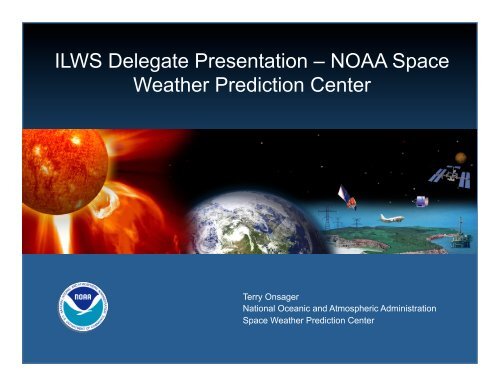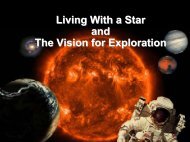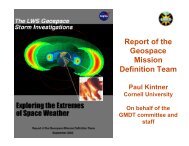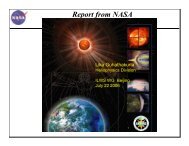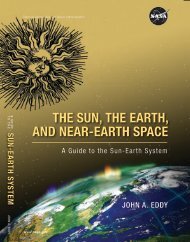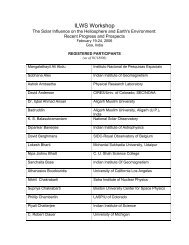NOAA Space Weather Prediction Center
NOAA Space Weather Prediction Center
NOAA Space Weather Prediction Center
You also want an ePaper? Increase the reach of your titles
YUMPU automatically turns print PDFs into web optimized ePapers that Google loves.
ILWS Delegate Presentation – <strong>NOAA</strong> <strong>Space</strong><br />
<strong>Weather</strong> <strong>Prediction</strong> <strong>Center</strong><br />
Terry Onsager<br />
National Oceanic and Atmospheric Administration<br />
<strong>Space</strong> <strong>Weather</strong> <strong>Prediction</strong> <strong>Center</strong>
Growth in Subscribers to <strong>Space</strong> <strong>Weather</strong> <br />
Products <br />
Sunspot Number<br />
Subscrip)on <br />
service began <br />
Customers Include:<br />
All major airlines<br />
Drilling and oil exploration<br />
Satellite companies<br />
Transportation sector<br />
Emergency responders<br />
Number of Subscribers
Interna6onal and U.S. Subscribers to <strong>NOAA</strong>’s <br />
<strong>Space</strong> <strong>Weather</strong> Products <br />
35000 <br />
30000 <br />
International and U.S. Subscribers to <strong>NOAA</strong>'s<br />
<strong>Space</strong> <strong>Weather</strong> Products<br />
Number of Subscribers<br />
25000 <br />
20000 <br />
15000 <br />
10000 <br />
International Subscribers<br />
U.S. Subscribers<br />
5000 <br />
0 <br />
2005 2006 2007 2008 2009 2010 2011 8/2012
Major Forecast <strong>Center</strong> Products<br />
• Long lead-time forecasts (1 to > 3 days)<br />
• Short-term warnings (notice of imminent storm)<br />
• Alerts and Specifications (current conditions)<br />
<strong>Space</strong> <strong>Weather</strong> Category:<br />
• X-ray flares<br />
• Solar energetic particle events<br />
• Geomagnetic storms<br />
• Radiation belt electron enhancements<br />
• Ionospheric disturbances<br />
• Solar radio flux
Real-Time Observations are the Foundation for<br />
Products and Services<br />
NASA STEREO<br />
(Ahead)<br />
Challenge: Coordinating global data planning,<br />
acquisition, and dissemination<br />
• ACE (NASA)<br />
– Solar wind speed,<br />
density, temperature<br />
and energetic particles<br />
– Vector Magnetic field<br />
• SOHO (ESA/NASA)<br />
– Solar EUV Images<br />
– Solar Corona<br />
(CMEs)<br />
ESA/NASA SOHO<br />
NASA ACE<br />
<strong>NOAA</strong> GOES<br />
• Ground Sites<br />
– Magnetometers<br />
– Riometers and Neutron<br />
monitors<br />
– Telescopes and Magnetographs<br />
– Ionosondes<br />
– GNSS<br />
• COSMIC II<br />
(Taiwan/<strong>NOAA</strong>)<br />
– Ionospheric Electron<br />
Density Profiles<br />
– Ionospheric<br />
Scintillation<br />
• STEREO (NASA)<br />
– Solar Corona<br />
– Solar EUV Images<br />
– Solar wind<br />
– Vector Magnetic field<br />
Satellite Observations for<br />
NASA<br />
Future<br />
STEREO<br />
<strong>Space</strong> <strong>Weather</strong><br />
(Behind)<br />
Forecasting<br />
• GOES (<strong>NOAA</strong>)<br />
– Energetic Particles<br />
– Magnetic Field<br />
– Solar X-ray Flux<br />
– Solar EUV Flux<br />
– Solar X-Ray Images<br />
5<br />
<strong>NOAA</strong> POES<br />
• POES (<strong>NOAA</strong>)<br />
– High Energy Particles<br />
– Total Energy Deposition<br />
– Solar UV Flux
Deep <strong>Space</strong> Climate Observatory (DSCOVR) <br />
Solar Wind Mission <br />
• The DSCOVR spacecraS will be refurbished and <br />
readied for launch in November, 2014 <br />
• Refurbishment of satellite and Plas-‐Mag sensor is <br />
being performed at NASA/GSFC under reimbursement <br />
by <strong>NOAA</strong> <br />
• USAF plans to launch on <strong>Space</strong>-‐X Falcon 9 (Version <br />
1.1) <br />
• All data will be downlinked to the Real Time Solar <br />
Wind Network (RTSWnet) <br />
• Expected opera6onal date: June, 2015
Compact Coronagraph (CCOR) <br />
• Naval Research Laboratory completed a <strong>NOAA</strong>-‐funded Phase A study for a <br />
demonstra6on compact coronagraph <br />
• CCOR is a reduced mass, volume, and cost coronagraph design <br />
– 6 kg telescope, 17 kg for sensor <br />
– Op6cal train is 1/3 the length of tradi6onal coronagraph designs <br />
• CCOR launch opportuni6es are being inves6gated
Sunjammer – Solar Sail Mission <br />
• Sunjammer will fly to 2xL1, then out of the ecliptic -<br />
Launch in late 2014/early 2015<br />
• Technology demonstration for the sail and for<br />
making measurements in the presence of a sail<br />
• <strong>NOAA</strong> partnered with L’Garde to provide tracking<br />
and to procure a payload<br />
• Imperial College London will provide magnetometer<br />
• University College London/MSSL will provide a<br />
charged particle spectrometer<br />
• SWPC will assist in evaluating the data and will<br />
potentially use the data operationally
COSMIC 2 <br />
• Joint Taiwan-U.S. 12-satellite constellation<br />
• GNSS Radio-Occultation measurements – GPS, Galileo, and GLONASS<br />
• 6 low-inclination and 6 high-inclination satellites<br />
• First launch (6 low-inclination) planned for 2016<br />
• <strong>NOAA</strong> is working with international partners to host/operated datareceiving<br />
ground stations<br />
• Mission will acquire more than 8000 ionospheric soundings per day
Components of <strong>NOAA</strong>’s Numerical <strong>Space</strong> <br />
<strong>Weather</strong> Modeling Effort <br />
Solar /Solar Wind<br />
Magnetosphere/<br />
Ionosphere<br />
Atmosphere/<br />
Ionosphere<br />
L1 Satellite Location – ACE and Future DSCOVR
Determining the Ini6al Proper6es of CMEs is <br />
Important for Predic6ng Their Arrival <br />
WSA-Enlil Model of Background Solar Wind<br />
SOHO LASCO Coronagraph<br />
STEREO-A<br />
Ecliptic Plane<br />
Sun<br />
Earth<br />
NASA STEREO Coronagraph<br />
STEREO-B<br />
D. Odstrcil
Coronagraph Data and CME Fieng Tool are <br />
Used to Es6mate Ini6al CME Velocity <br />
G. Millward, SWPC and University of Colorado
CME <strong>Prediction</strong>s Improve Forecasts of<br />
Geomagnetic Storms<br />
1 – 4 day advance warning of large storms<br />
Density<br />
Ecliptic Plane<br />
Azimuthal Plane<br />
Wang-Sheeley-Arge<br />
(WSA)/Enlil<br />
(Dusan Odstrcil)<br />
Kp index <br />
geomagne6c <br />
ac6vity <br />
G. Millward, Univ. of Colorado/SWPC
Challenges to Overcome in Predic6ng CME <br />
Arrival Time and Impacts <br />
• Satellite-based measurements of Coronal Mass Ejections<br />
• Improved techniques for initializing the background solar wind model<br />
• Improved techniques for initializing the CME model<br />
• Characterization of the internal magnetic field structure within CMEs<br />
Pizzo<br />
D. Odstrcil<br />
Lugaz et al, 2007
Components of <strong>NOAA</strong>’s Numerical <strong>Space</strong> <br />
<strong>Weather</strong> Modeling Effort <br />
Solar /Solar Wind<br />
Magnetosphere/<br />
Ionosphere<br />
Atmosphere/<br />
Ionosphere<br />
L1 Satellite Location – ACE and Future DSCOVR
Electric Power Impacts – October, 2003 <br />
Sweden:<br />
- Power outage<br />
- Transformer heating in<br />
nuclear plant<br />
United States:<br />
- Power reduced at nuclear<br />
facilities to mitigate impacts<br />
South Africa:<br />
- 14 transformers damaged<br />
- $60 million impact<br />
- Basic commerce and security impaired
Regional Predic6ons of Geomagne6c <br />
Disturbances <br />
• Current forecasts do not resolve regional differences in activity<br />
• Evaluation of geomagnetic activity models is occurring – involving<br />
<strong>NOAA</strong>, CCMC, MHD modelers, and empirical modelers<br />
• Transition to operations could begin in 2013<br />
Kp - Global Measure of<br />
Geomagnetic Activity<br />
G. Millward
Components of <strong>NOAA</strong>’s Numerical <strong>Space</strong> <br />
<strong>Weather</strong> Modeling Effort <br />
Solar /Solar Wind<br />
Magnetosphere/<br />
Ionosphere<br />
Atmosphere/<br />
Ionosphere<br />
L1 Satellite Location – ACE and Future DSCOVR
Ionospheric Disturbances Occur at All<br />
Latitudes<br />
• Ionospheric disturbances create communication, navigation, positioning,<br />
and timing errors and loss of signal.<br />
• Highest occurrence frequency is at low and high latitudes. During large<br />
storms, disturbances extend into mid latitudes.<br />
Scintillation Occurrence<br />
Frequency<br />
Frequent<br />
Infrequent<br />
Kintner et al., 2009
Ionosphere is Driven both from<br />
<strong>Space</strong> and from the Atmosphere
Coupling of Atmospheric Dynamic to the <br />
Ionosphere System <br />
Model development includes collaboration with UK researchers and the UK Met Office<br />
Whole Atmosphere Model (WAM = Extended GFS) <br />
Ionosphere Plasmasphere Electrodynamics (IPE) <br />
Integrated Dynamics in Earth’s Atmosphere (IDEA = WAM+IPE) <br />
Ionosphere Plasmasphere<br />
Electrodynamics (IPE) Model<br />
Plasmasphere<br />
WAM: Neutral<br />
Atmosphere<br />
0 – 600 km<br />
Ionosphere<br />
GFS<br />
0 – 60 km<br />
Stratosphere<br />
Troposphere<br />
Thermosphere<br />
Mesosphere<br />
WAM<br />
R. Viereck, <strong>NOAA</strong>/SWPC
Addi6onal Areas Where Research Advances <br />
are Needed <br />
• Solar Active Region Eruption<br />
- Probability of near-term eruption of solar<br />
active region<br />
- Probability of intense flare x-rays<br />
- Probability of energetic particle acceleration<br />
• Radiation environment at Earth<br />
- Probability of solar energetic particles<br />
- Probability of intense electron radiation belts


